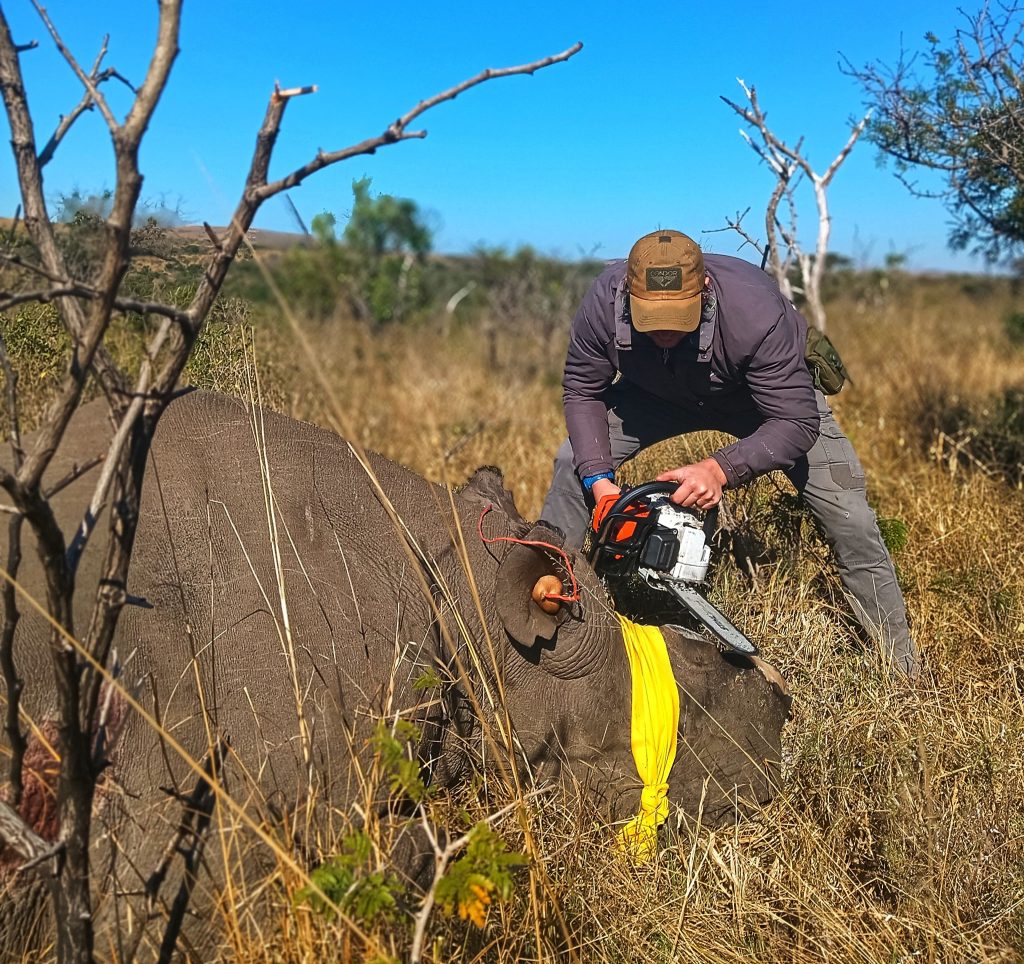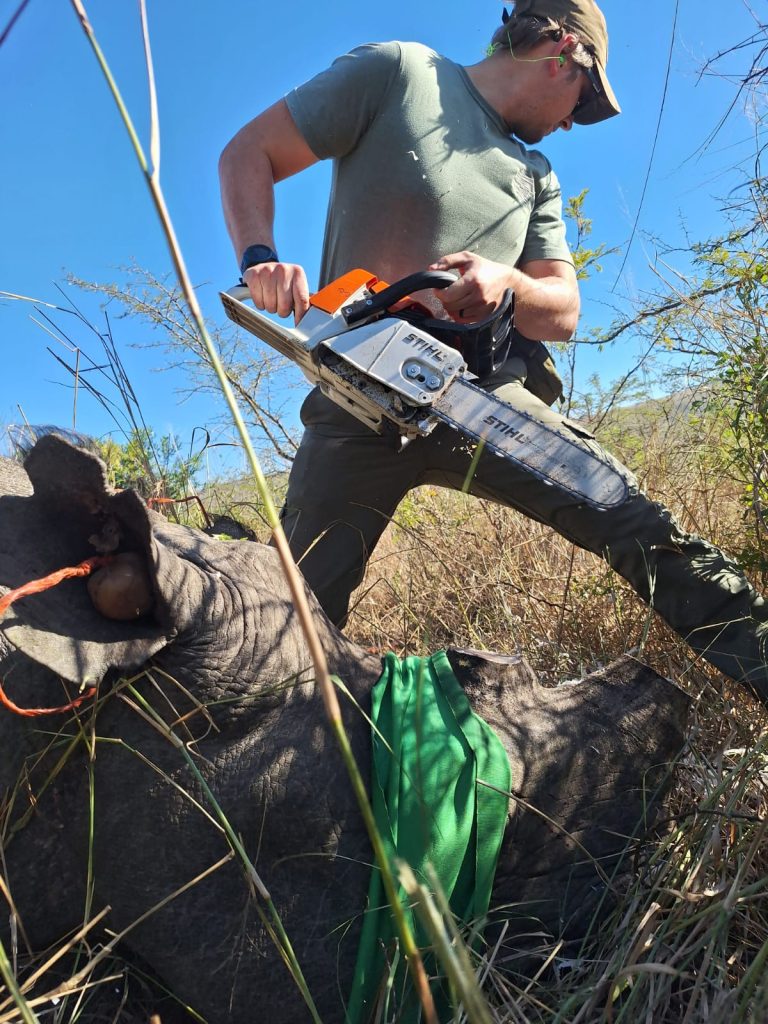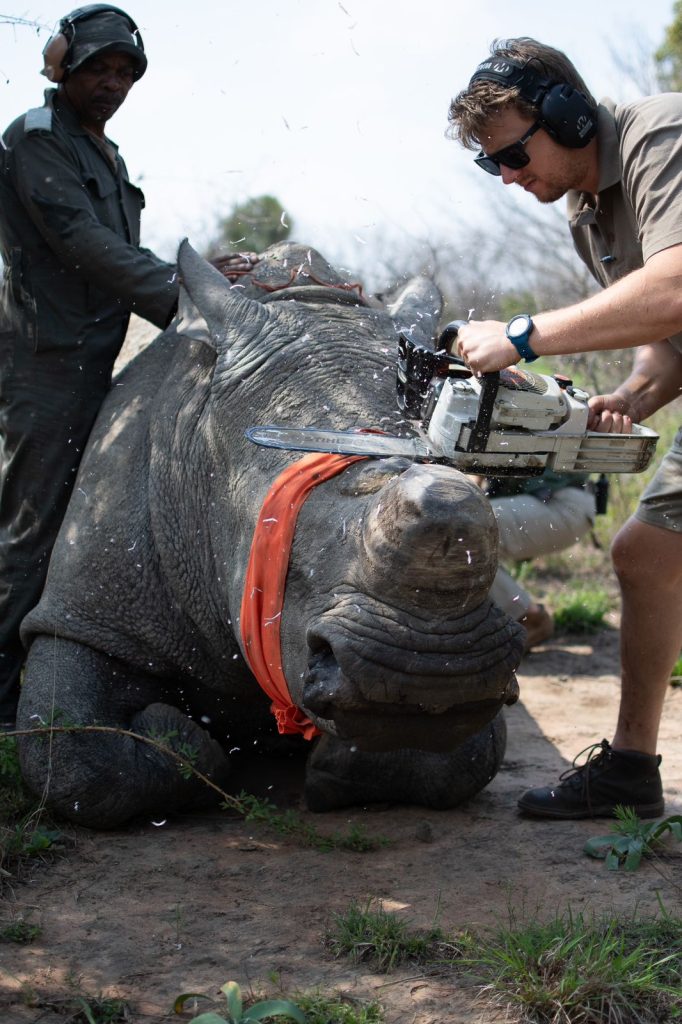Blog Posts
THE TOOL OF CHOICE; DR ROWAN LEEMING’S INSIGHT INTO RHINO DEHORNING WITH STIHL CHAINSAWS
When I started my career, I never thought that I would be taking a chainsaw to a rhino horn as much as we do, but then again, I never imagined I would see the absolute brutality that these animals go through.
Rhino dehorning – what a bizarre concept. Removing a characteristic feature that makes a rhino a rhino, all because of the greed of human nature. Through my time with Ezemvelo KZN Wildlife (EKZNW), I have witnessed unfathomable brutality towards rhino, all for their horns made up of the same stuff as human fingernails; keratin. How humans can assign such great, dark value to a substance that is essentially a fingernail is beyond me. The surge in rhino poaching resulted in desperate measures to protect the rhino species. In 2023 alone, 499 rhinos were poached in South African of which 307 were in Hluhluwe-iMfolozi Park.
Dehorning fast became one of the best proactive measures in safeguarding rhino populations in protected areas. It is, by no means a silver bullet to solve the crisis, as the root of the problem – the demand for rhino horn – still looms like a dark cloud hanging over the species. However, when combined with increased security measures and other rhino protection tools, it increases the risk for rhino poachers while diminishing their potential reward, making them less willing to risk their lives to satisfy the people driving the demand.

People always ask us, “how do you feel about dehorning rhino?” I try not admitting that it’s an internal struggle removing a characteristic feature of an animal, some with seemingly record- breaking horns that would make anyone stop and look in awe; that it gives me mixed feelings as the chain goes through the last bit of horn and this once upward facing monument to this animal falls to the floor. At the same time, I always tell people that it feels great knowing you are making a difference; despite the unfortunate circumstances, I would rather see a rhino with no horn than no rhino at all, and by dehorning rhino we can give them the chance to exist despite their severe persecution. I am also heavily blessed that all our dehorning operations have given me the chance to work very closely with these animals. I have also gained a massive amount of experience with both black and white rhino, something to which other vets dream about.
These positive things are what I try focus on when I start a chainsaw and step up to the side of a rhino, and I realise that I am extremely fortunate to be on the ground fighting for the survival of this species. I am sure that anyone who has handled a chainsaw will know that it is not a machine to be taken lightly or become complacent with. Strap a high-performance engine to a spinning blade with many little cutting teeth rotating in excess of 22 metres per second and you get a highly effective, dangerous cutting machine. I had had very little chainsaw experience when I started at the boom of this dehorning period, but I was fortunate to have a few mentors and good guidance. My heart was racing the first time I was handed a chainsaw to dehorn my first rhino, a Stihl MS250. I was closely watched and guided as I cut through my first horn. A bit rough, but overly safe is how I would describe it. It is a good idea to be overly cautious and focus on safe technique when starting out.
More experienced members of EKZNW’s Game Capture team would step in to touch up my early handywork, and after doing a few more rhino I started learning more and more and in a short space of time, I got my handling and technique set to an acceptable level.

During an early dehorning operation, the Stihl team joined us on capture to see their generously donated machines in action. I remember Stihl Managing Director, Hayden Hutton showing me a few things on handling the saw, which looked like absolute artwork. Seeing this, I thought to myself “I’ve still got a long way to go…” but it completely revolutionised the way I dehorn rhino and ultimately developed into how I dehorn rhino today.
The Stihl MS250 was one of the first chainsaws donated and was our go to saw. It was the saw I learnt on and became familiar with. As one does, with tools worked with on a regular basis, I got to know the workings and capabilities of the MS250 quite well. It was small enough to handle all day in every which angle and position I needed to use the saw, but at the same time powerful enough to cut through the biggest horns. There were times, of course, when a rapid succession of animals would be immobilized without time in between to sharpen or replace chains, that it would seem to struggle, but never to the point in which we could not complete the task at hand. For the power to size ratio and experience we gained on this machine, the MS250 became a favourite among the Game Capture Team.
Enter the Hluhluwe iMfolozi Park Dehorning Operation. It’s important to note that our Game Capture Unit had probably dehorned over 700 rhino before this operation took place. It was safe to say, we were not unfamiliar with the mammoth task that lay ahead of us. So, when Stihl kindly offered to donate new chainsaws to the cause, our go-to saw was the MS250. The operation commenced with great efficiency, and we were fast on track in undertaking probably one of the biggest rhino conservation efforts in history since “Operation Rhino” in the 1970s.

When Hayden and Kyle Brooks (Stihl Product Trainer) popped in to see their Stihl machines in action, a large number of the rhino population had already been worked through, and I would like to think that they were suitably impressed by our performance and their contribution to this cause. One night around the campfire as the day’s stories and events winded down, sometimes so comically illustrated to the point where even the hyaena’s would wonder what had happened, Hayden and Kyle suggested we should give the MS260 a go. To be honest, I’m not sure to this day why they were keeping this chainsaw a secret from us all this time. Although it was never really the case of keeping it a secret, more so really of our own ignorance. I suppose we were so set in our ways, we never really thought of the possibility of swapping out our beloved MS250 with its professional counterpart, and we didn’t really want to push the envelope on an already extremely generous donation.
Kyle quickly sourced a MS260 from his arsenal and loaned it to us on a trial basis so we could see what they were talking about. Sceptical at first, we thought “how much better could it really be?” – it was the same size after all, and the MS250 had proven itself over the years. But after the chain seared through the first horn like a hot knife through butter, it became very clear to me; the MS260 was like the Eben Etzebeth version of the MS250. With an extra bump of power in the same size chassis as the MS250, it exceeded every expectation I had. I never really thought that my dehorning technique could evolve more than what it had already, but with the MS260, it gave me even more confidence to continue this fight. After I expressed my jubilation to Hayden and Kyle with this machine, I think they felt too bad to take away this new level I had experienced, and Kyle’s beloved MS260 was graciously donated to African Wildlife Vets for it’s continued use in our dehorning efforts throughout all Ezemvelo KZN Wildlife Reserves. We can’t thank Stihl enough, not only for the donation of this chainsaw, but for their continued support in our efforts of rhino dehorning.
October 2024
Author: Dr Rowan Leeming

